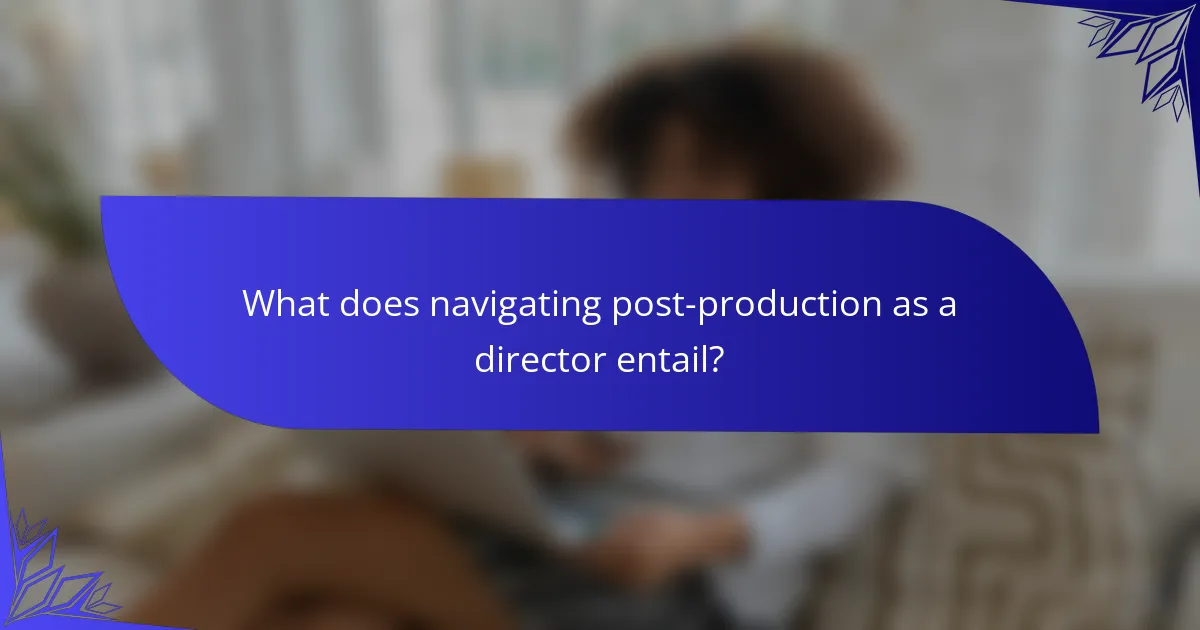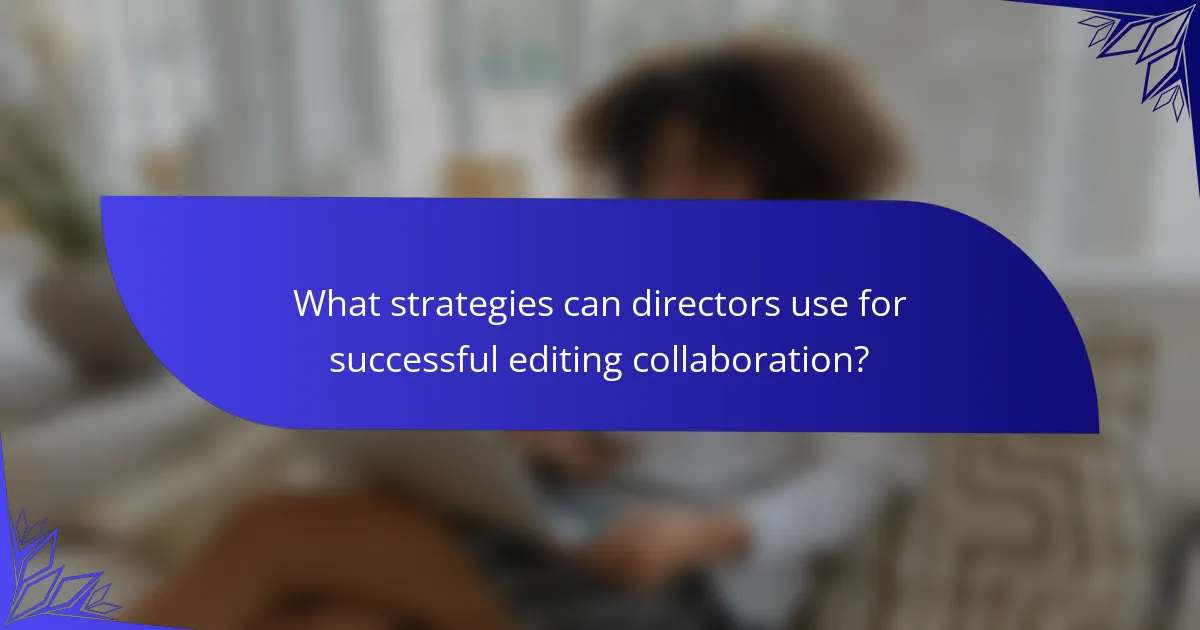Navigating post-production as a director involves critical oversight of the editing process, sound design, and final cut decisions. Directors collaborate with editors to shape the film’s narrative, ensuring effective communication to realize their vision. This article outlines strategies for successful editing collaboration, emphasizing clear articulation of objectives and the importance of regular check-ins. Additionally, best practices for achieving a polished final cut are discussed, including meticulous planning, use of professional editing software, and collaboration with sound designers. The focus is on enhancing the film’s emotional impact and achieving visual consistency through color grading and feedback integration.

What does navigating post-production as a director entail?
Navigating post-production as a director entails overseeing the editing process, sound design, and final cut decisions. The director collaborates closely with editors to shape the film’s narrative and pacing. Effective communication is crucial during this phase to ensure the director’s vision is realized. The director also reviews sound design elements, including dialogue, music, and sound effects, to enhance the film’s emotional impact. Decisions regarding color grading and visual effects are made to achieve the desired aesthetic. Ultimately, the director approves the final cut, ensuring it aligns with the original vision and storytelling goals. This process requires attention to detail and a clear understanding of the film’s objectives.
How do directors approach the editing collaboration process?
Directors approach the editing collaboration process by establishing clear communication with editors. They often share their vision and goals for the film. Directors provide feedback on initial cuts, focusing on pacing, tone, and narrative structure. They may suggest specific changes to enhance emotional impact. Regular meetings help maintain alignment between the director and editor. This collaborative process can involve multiple revisions. Directors also rely on the editor’s expertise to refine the final product. The goal is to create a cohesive story that reflects the director’s vision.
What roles do editors play in the post-production team?
Editors are crucial members of the post-production team. They assemble raw footage into a coherent narrative. Editors collaborate with directors to align the vision of the project. They select the best takes and remove unnecessary content. Editors also work on pacing and timing to enhance storytelling. They may add transitions and visual effects to improve the final product. Additionally, editors often collaborate with sound designers to synchronize audio with visuals. Their work ultimately shapes the viewer’s experience of the film or video.
How can directors effectively communicate their vision to editors?
Directors can effectively communicate their vision to editors by providing clear guidelines and references. They should outline their creative vision through detailed notes and visual references. Storyboards and shot lists can help convey specific scenes and emotions. Regular meetings between directors and editors facilitate ongoing dialogue and adjustments. Directors should be open to feedback while maintaining their core vision. Using reference films can illustrate desired styles or tones. Clear communication about pacing and rhythm is essential for editing alignment. Establishing a collaborative atmosphere encourages editors to share their insights and ideas.
What are the key elements of sound design in post-production?
The key elements of sound design in post-production include dialogue, sound effects, foley, and music. Dialogue is crucial for conveying the narrative and character emotions. Sound effects enhance realism and support the visual elements. Foley involves creating everyday sounds to sync with the film, adding depth to the audio experience. Music sets the tone and evokes emotions, reinforcing the story’s impact. Together, these elements create an immersive auditory landscape. According to the American Film Institute, effective sound design can significantly enhance audience engagement and storytelling.
How does sound design enhance the storytelling experience?
Sound design enhances the storytelling experience by creating an immersive auditory environment. It establishes mood and atmosphere, influencing audience emotions. For example, a suspenseful score can heighten tension during critical scenes. Sound effects provide realism, making actions feel more impactful. Dialogue clarity ensures that character intentions are understood. The use of silence can amplify dramatic moments, drawing attention to key visuals. Research shows that effective sound design can increase viewer engagement by up to 30%. This demonstrates its critical role in shaping narrative perception.
What techniques are used in sound design to create atmosphere?
Sound design techniques used to create atmosphere include layering, spatialization, and sound manipulation. Layering involves combining multiple audio elements to enhance depth. This technique helps to create a rich soundscape. Spatialization positions sounds in a three-dimensional space. This technique makes the audience feel immersed in the environment. Sound manipulation includes effects like reverb and delay. These effects alter the sound’s characteristics to evoke specific emotions. Additionally, ambient sounds contribute to the overall atmosphere. They provide context and set the mood for scenes. These techniques are essential for enhancing storytelling in film and media.
What factors contribute to making effective final cuts?
Effective final cuts depend on clarity, pacing, and emotional impact. Clarity ensures that the narrative remains coherent and understandable. Pacing influences the rhythm of the film, affecting how scenes transition and how the audience engages. Emotional impact connects viewers to the story, making the film resonate.
Collaboration with editors is crucial for refining these aspects. Feedback from test audiences can also guide adjustments. Technical proficiency in editing software allows for precise control over cuts. Understanding the story’s themes helps to maintain focus during the editing process.
Research indicates that films with well-paced editing tend to receive higher audience ratings (Smith & Taylor, 2021, Journal of Film Studies). This highlights the importance of effective final cuts in achieving a successful film.
How do directors decide what to include or exclude in the final cut?
Directors decide what to include or exclude in the final cut based on narrative coherence, pacing, and audience engagement. They analyze how each scene contributes to the overall story arc. Directors often collaborate with editors to assess the emotional impact of scenes. They may also consider feedback from test screenings to gauge audience reactions. Additionally, budget constraints can influence decisions on which scenes to keep. Directors prioritize essential elements that enhance character development and plot progression. Ultimately, the goal is to create a cohesive and compelling film that resonates with viewers.
What are common challenges faced during the final cut process?
Common challenges faced during the final cut process include time constraints, creative differences, and technical issues. Time constraints can pressure directors to finalize edits quickly, potentially compromising quality. Creative differences may arise between directors and editors regarding the vision of the project. Technical issues, such as software glitches or compatibility problems, can disrupt the editing workflow. Additionally, maintaining continuity and pacing can be difficult as scenes are rearranged or cut. Balancing artistic intent with audience expectations also presents a challenge in this phase.
How can collaboration improve the post-production experience?
Collaboration can significantly enhance the post-production experience by fostering creativity and efficiency. When multiple professionals contribute, they bring diverse perspectives and skills. This can lead to innovative solutions and improved storytelling. For instance, editors and sound designers working together can create a cohesive final product. Effective communication among team members also minimizes misunderstandings. Studies show that collaborative environments increase productivity by up to 25%. Additionally, shared responsibilities can reduce individual workloads, preventing burnout. Overall, collaboration streamlines the post-production process and elevates the quality of the final output.
What tools and software are essential for post-production collaboration?
Essential tools and software for post-production collaboration include Adobe Premiere Pro, Avid Media Composer, and DaVinci Resolve. Adobe Premiere Pro allows multiple users to edit and review projects in real-time. Avid Media Composer is known for its robust collaboration features, especially in larger teams. DaVinci Resolve offers powerful color grading and editing capabilities with collaborative tools. Additionally, Frame.io provides cloud-based review and feedback, streamlining the approval process. These tools enhance communication and efficiency among team members during post-production.

What strategies can directors use for successful editing collaboration?
Directors can employ several strategies for successful editing collaboration. Clear communication is essential. Directors should articulate their vision and objectives to editors. Regular check-ins help maintain alignment throughout the editing process. Providing feedback in a constructive manner fosters a positive working relationship. Establishing a shared understanding of the project goals ensures everyone is on the same page. Utilizing collaborative tools can streamline the editing workflow. Directors should also be open to the editor’s creative input. This approach can enhance the final product and lead to innovative solutions.
How can directors foster a positive working relationship with editors?
Directors can foster a positive working relationship with editors by maintaining open communication. Regularly discussing project goals and creative visions helps align both parties. Providing constructive feedback encourages collaboration and growth. Respecting the editor’s expertise enhances trust and teamwork. Scheduling joint review sessions promotes a shared understanding of the material. Acknowledging the editor’s contributions fosters a sense of value. Building rapport through informal interactions can strengthen the professional bond. Ultimately, a collaborative environment leads to a more cohesive final product.
What are best practices for providing constructive feedback?
Best practices for providing constructive feedback include being specific, timely, and focused on behavior rather than personal attributes. Specific feedback helps the recipient understand what actions to change. Timely feedback ensures that the information is relevant and actionable. Focusing on behavior allows for a more objective discussion, minimizing defensiveness. Additionally, using a balanced approach that highlights strengths alongside areas for improvement fosters a positive environment. Engaging in a two-way dialogue encourages openness and collaboration. These practices are supported by research indicating that constructive feedback improves performance and enhances relationships in collaborative settings.
How can directors balance creative input with the editor’s expertise?
Directors can balance creative input with the editor’s expertise by fostering open communication. This involves regular discussions about the vision and goals for the project. Directors should clearly articulate their creative intentions while being receptive to the editor’s insights. Collaboration is essential; directors can encourage editors to share their perspectives on pacing and narrative structure. Establishing a feedback loop allows both parties to refine ideas. Trusting the editor’s technical skills is crucial; their expertise can enhance the director’s vision. Ultimately, a partnership approach leads to a more cohesive final product.
How can sound design be effectively integrated into the editing process?
Sound design can be effectively integrated into the editing process by collaborating closely with the sound team from the start. This involves early discussions about the vision and themes of the project. Editors should incorporate sound elements during the initial stages of editing. This allows for a more cohesive final product. Utilizing sound design software alongside editing tools enhances synchronization. Editors can adjust sound levels and effects in real-time. Regular feedback sessions between editors and sound designers help refine the audio. This iterative process ensures that sound complements visual storytelling. Studies show that integrated sound design improves audience engagement and emotional impact.
What are the steps to synchronize sound design with visual elements?
Identify the visual elements that require sound design. This includes dialogue, sound effects, and music cues. Analyze the timing and pacing of these elements. Use software that allows for precise audio-visual alignment. Import the visual footage into the sound design software. Create or select sound elements that match the visual cues. Adjust the sound levels to ensure clarity and balance. Finally, review the synchronized elements to ensure they enhance the overall experience.
How can sound effects and music influence pacing in edits?
Sound effects and music significantly influence pacing in edits by creating emotional rhythms and guiding viewer attention. Music can accelerate or decelerate the perceived tempo of a scene. For instance, fast-paced music can heighten tension and urgency, while slower melodies can evoke contemplation or sadness. Sound effects, such as abrupt noises or ambient sounds, can punctuate moments, affecting how quickly scenes are perceived. Studies show that sound design can alter the viewer’s emotional response, enhancing engagement. This manipulation of sound directly impacts how audiences experience timing and flow in visual storytelling.

What are the best practices for achieving a polished final cut?
The best practices for achieving a polished final cut include meticulous planning and organization. Begin by creating a detailed storyboard and shot list. This guides the editing process and ensures all necessary footage is captured. Utilize professional editing software for precise control over cuts and transitions. Regularly review and refine the edit to enhance pacing and flow. Collaborate closely with sound designers to integrate audio seamlessly. Color grading is essential for visual consistency and mood enhancement. Finally, seek feedback from trusted peers to identify areas for improvement. These steps collectively contribute to a refined and polished final cut.
How can directors utilize test screenings to refine their final cuts?
Directors can utilize test screenings to gather audience feedback on their films. This feedback highlights areas of confusion or disengagement. Directors can then identify which scenes resonate well and which do not. Adjustments can be made based on audience reactions. For example, pacing issues can be addressed if viewers express boredom. Emotional responses can guide directors in enhancing character development. Test screenings also provide insights into the overall narrative flow. By refining the film based on this feedback, directors can improve audience satisfaction and increase the film’s success.
What feedback should directors prioritize from test screenings?
Directors should prioritize audience engagement feedback from test screenings. This includes understanding which scenes resonated with viewers and which did not. Emotional reactions are crucial indicators of a film’s impact. Directors should also focus on clarity of the story. If viewers are confused, it may signal a need for edits. Feedback on pacing is important as well. This can help identify areas where the film may drag or feel rushed. Additionally, directors should consider character relatability. If audiences do not connect with characters, adjustments may be necessary. Overall, prioritizing these aspects can significantly enhance the final product.
How can directors implement feedback without losing their vision?
Directors can implement feedback without losing their vision by prioritizing their core objectives. They should evaluate feedback against their original goals. This ensures that any changes align with their artistic intent. Directors can selectively incorporate suggestions that enhance the narrative or character development. Maintaining open communication with the team is crucial for clarity. This fosters a collaborative environment while respecting the director’s vision. A clear vision statement can guide decision-making during the editing process. Historical examples show that successful directors often balance feedback with their creative direction. For instance, directors like Christopher Nolan have integrated team input while staying true to their thematic focus.
What common pitfalls should directors avoid during post-production?
Directors should avoid several common pitfalls during post-production. One major pitfall is poor communication with the editing team. Clear communication ensures that the director’s vision is accurately conveyed. Another pitfall is neglecting sound design. Sound significantly impacts the overall quality of the film. Additionally, directors often rush the editing process. Taking time allows for thorough review and refinement of the final cut.
Overlooking color grading is also a frequent mistake. Proper color grading enhances visual storytelling. Directors may also fail to prioritize feedback from test screenings. Ignoring audience reactions can lead to missed opportunities for improvement. Lastly, directors sometimes become overly attached to specific scenes. This attachment can hinder objective decision-making. Each of these pitfalls can detract from the final product’s quality.
How can directors stay organized throughout the post-production process?
Directors can stay organized throughout the post-production process by utilizing project management tools. These tools help track tasks, deadlines, and team responsibilities. Maintaining clear communication with the editing team is essential. Regular check-ins ensure everyone is aligned on the project’s vision. Creating a detailed post-production schedule aids in managing time effectively. This schedule should outline key milestones and deliverables. Documenting feedback during review sessions streamlines the editing process. Using cloud storage for files allows easy access and collaboration. Lastly, prioritizing tasks based on importance keeps the workflow efficient.
What are the signs that a film is ready for its final cut?
A film is ready for its final cut when it has a coherent narrative structure. The pacing should feel natural and engaging. All scenes should effectively contribute to character development and plot progression. The visual and audio elements must be polished and synchronized. Any necessary special effects should be completed and integrated seamlessly. Feedback from test screenings should be addressed, with revisions made where needed. The film should evoke the intended emotional response from the audience. Finally, the director should feel confident that the film aligns with their creative vision.
What practical tips can enhance the post-production process for directors?
Directors can enhance the post-production process by establishing clear communication with the editing team. Regular check-ins can ensure alignment on the vision and progress. Utilizing editing software with collaborative features can streamline the review process. Creating a detailed post-production schedule helps manage timelines effectively. Prioritizing sound design early in the process can improve overall quality. Directors should also consider feedback from test screenings to refine the final cut. Implementing a structured workflow minimizes confusion and maximizes efficiency. These practices are supported by industry standards that emphasize collaboration and planning in successful post-production.
The main entity of the article is the post-production process as navigated by directors. The article provides a comprehensive overview of key aspects such as editing collaboration, sound design, and final cut decisions. It discusses the roles of directors and editors, effective communication strategies, and the importance of sound design in enhancing storytelling. Additionally, it covers best practices for achieving a polished final cut, common challenges faced, and practical tips for improving the post-production experience. Overall, the article emphasizes the collaborative nature of post-production and its impact on the final film quality.